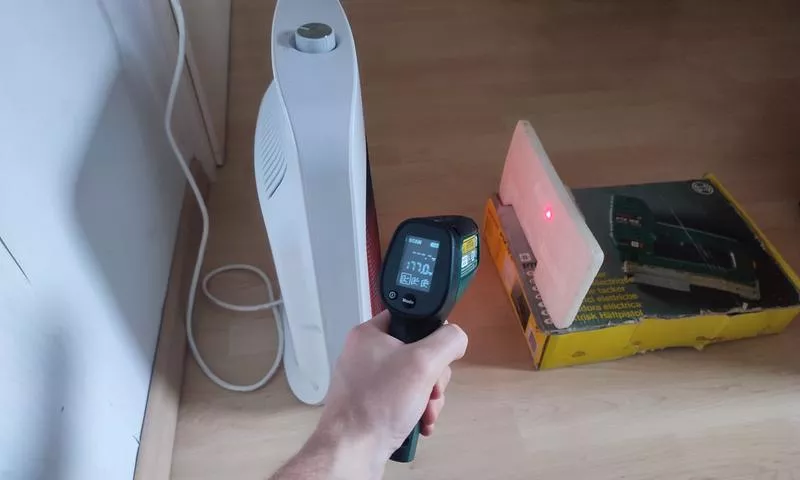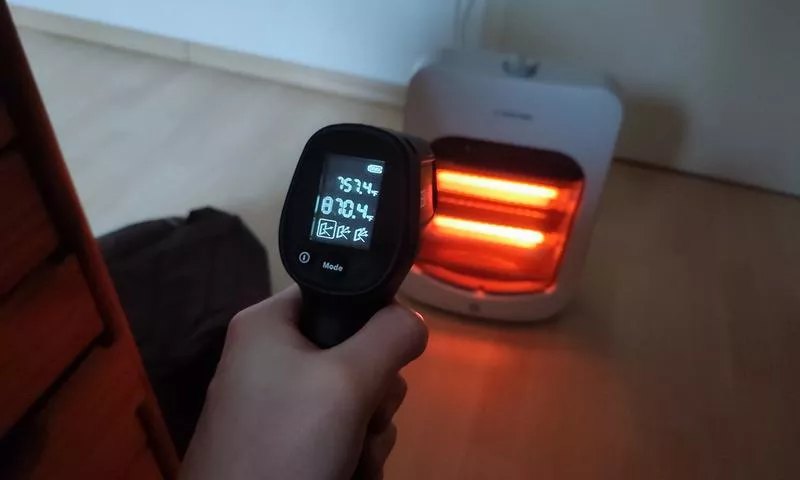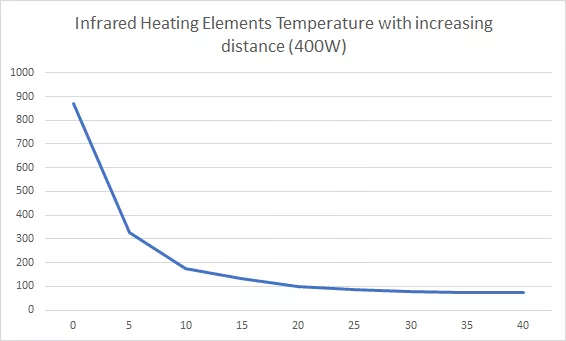Can you run an infrared heater all night? In this article, we’re going to measure the temperature of my infrared heater’s heating elements.
Then, we can check whether this temperature is night-safe (i.e. will it burn or melt anything?).
Also, I am going to recommend you a night-safe infrared heater.
Quick answer: Yes, you can run a quality infrared heater overnight given it is made of fireproof material and has built-in overheat protection. The radius of up to 2 feet in front of a space heater has to be free of any objects, as within this radius high temperatures up to 750°F can occur. Place your infrared heater at a safe distance from your bed without any objects blocking the heat radiation.
Here’s an infrared heater that you can use:
Recommended infrared heater for overnight usage
The best infrared heater for 24/7 usage is this Dr. Infrared heater (click here to view it on amazon).
It is superior to most other infrared heaters because it is made of real wood (which has a higher ignition temperature than plastic).
The Dr. Infrared heater is strong enough to heat any room to a comfortable temperature. You can run them safely overnight in your bedroom or living room.
Still not sure? This one is my favorite infrared heater. So, I’ve dedicated an entire page to it. Read my full Dr. Infrared Heater review here.
Anyways, let’s have a look at the experiment I did:
How hot does an Infrared Heating Element get? (Experiment)
When you use an infrared heater overnight, it is important to know which temperatures occur in front of it.
Only by knowing these temperatures, we can know whether infrared heaters can be a safety hazard.
To find out, I placed a styrofoam block in front of my running infrared heater.
By varying the distance of the styrofoam block and measuring the styrofoam’s temperature using a laser thermometer, we can find out how infrared heat spreads!

Here’s the result:
The display of my laster thermometer displayed values between 750°F and 900°F depending on where I pointed it.
When I switched the measurement unit to Celsius, it showed “>500°C”.
That’s very hot.
Note that this is the surface temperature of the heating elements.
The air in front of the heating elements is not that hot.
An average infrared heating element gets up to 870°F. Heating elements that consume more power will likely get even hotter.
The heating element under test consumes 400W of power. The temperature was measured when turned on along with a second 400W heating element, resulting in a total power consumption of 800W.
I suspect that space heaters with higher power (e.g. 1,500W) do not necessarily get hotter. Instead, they use larger heating elements or more heating elements in parallel.
 Infrared heating element temperature measurement: It’s over 870°F!
Infrared heating element temperature measurement: It’s over 870°F!
How does the temperature of an infrared heater change with distance?
An infrared heating element has a surface temperature of up to 870°F (465°C). As radiation spreads with increasing distance, the temperature of an infrared heating element measured from 5 inches is 327°F (164°C), and measured from 10 inches it’s only 176°F (80°C). Any distance above 15 inches from infrared heating elements is absolutely safe for humans, pets, and materials.
Here’s a graph displaying the temperature change with increasing distance.
 The temperature in front of my infrared heater. Measured using a Bosch laser thermometer and a styrofoam block.
The temperature in front of my infrared heater. Measured using a Bosch laser thermometer and a styrofoam block.
As you can see, infrared heaters get very hot in close proximity. But within a radius of 15 inches, the temperature cools down quickly.
At 5 inches and closer my styrofoam block started smoking and melting!
That’s why I couldn’t measure the temperatures even closer to the heating elements.
Here’s the same data in table format.
| Distance (in inches) | Temperature (in °F) |
|---|---|
| 0 inches | 870°F |
| 5 inches | 327°F |
| 10 inches | 176°F |
| 15 inches | 133°F |
| 20 inches | 101°F |
| 25 inches | 87°F |
| 30 inches | 79°F |
| 35 inches | 74°F |
| 40 inches | 72°F |
Can infrared heating elements melt or ignite something?
Infrared heater cases are often made of plastic.
In the table below we can see that most plastic materials start melting in the mid-200°C-range.
200°C is 392°F.
| Plastic types | Melting Point Range (℃) |
|---|---|
| Acrylic | 220 - 250 |
| CAB - Cellulose Acetate Butyrate | 170 - 240 |
| HDPE - High-Density Polyethylene | 210 - 270 |
| LDPE - Low-Density Polyethylene | 180 - 240 |
| Nylon 6 or Polyamide | 230 - 290 |
| Polycarbonate | 280 - 320 |
| Polyester PBT | 240 - 275 |
| PET (Amorphous) | 260 - 280 |
| PET (semi-crystalline) | 260 - 280 |
| Polypropylene (Homopolymer) | 200 - 280 |
| Polystyrene | 170 - 280 |
| PVC - Polyvinyl chloride | 160 - 210 |
| TPE - Thermoplastic Elastomer | 260 - 320 |
Melting point data from plasticranger.com
This means: Yes, an infrared heater can potentially melt any plastic that is in very close proximity (<5 inches) to it.
The surface temperature of the heating element is well over 750°F, which is well above the 392°F. required to melt plastic.
That’s why I don’t recommend running plastic infrared heaters overnight.
Even though they have built-in reflectors that reflect the heat outward, heat will accumulate with time.
Instead, use solidly built wood-case infrared heaters, such as the one I recommended at the beginning of this article.
Wood won’t melt.
The spontaneous ignition temperature of the wood is over 1100°F (600°C). Spontaneous ignition is ignition by temperature without any (human) intervention such as kindling.
So, wood is infrared heater safe.
Do infrared heating elements break down?
Infrared heating elements are usually simple electric resistors made of carbon, metal wire, or ceramic.
Even though they appear similar to fragile light bulbs (because of their glow), they are very different.
Infrared heating elements usually consist of solidly built parts that don’t “burn out” as a lightbulb would.
A thick metal wire or a piece of ceramic does not wear out or even break.
So, the heating element itself does not limit the time you can use your infrared heater.
It is very unlikely to break.
Do infrared heaters overheat?
Modern infrared heaters likely don’t overheat.
The first reason is their structure and design. Infrared heaters have a large opening to let the infrared radiation escape. This opening naturally prevents overheating.
But most modern infrared heaters have built-in overheat protection. The overheat protection in a space heater constantly monitors the temperature.
When the temperature is too high, the safety mechanism cuts off the heating.
So, it’s very unlikely that an infrared radiator overheats.
Well-built models (such as the Dr. Infrared heater I recommended earlier) won’t overheat when you run them overnight.
And even if they do, they cut off the heating.
On top of that, you can even set a timer on the heater’s front panel to auto-shutoff the heating after the set time.
Do infrared heater power cords overheat?
The power cord that is attached to your infrared heater can usually handle the current your space heater draws.
Problems arise as soon as you connect your space heater to an extension cord.
Cheap small gauge extension cords that are not designed for heavy-duty loads will overheat!
The reason is that these cheap extension cords have a too large electric resistance. Electrons have to “press through” this resistance. They bump into metal atoms inside the wire, which, in turn, wiggle around and cause overheating due to internal friction.
Always use a proper extension cord with your space heater.
Check this article for a heavy-duty extension cord recommendation:
Can you use an extension cord with a space heater?
Where to place an infrared heater overnight?
For running your infrared heater overnight, I recommend placing it at least 5 feet or more from your bed.
Any closer than that will likely get uncomfortably hot at night.
Ideally, for overnight heating, your infrared heater should stand on an elevated surface, such as a stool or a small pedestal.
This way you increase the amount of radiation that directly reaches you. Direct radiation increases the heat you feel.
And, in turn, you can decrease your infrared heater’s heating setting to save some energy (and money).
Conclusion
Yes, you can use an infrared heater overnight. However, make sure you use a quality space heater with built-in overheat protection.
Ideally, the infrared heater should be of a material that’s hard to ignite such as solid wood or fireproof plastic.
Make sure that no objects are within a close distance of your infrared heater, as the temperature rises exponentially, the closer you get to your infrared heater (as we’ve seen in the experiment).
